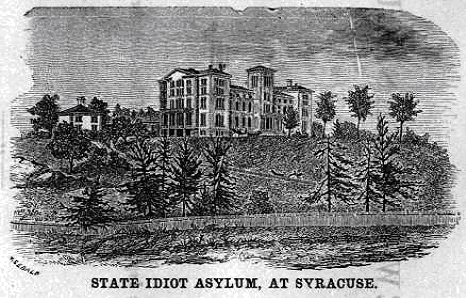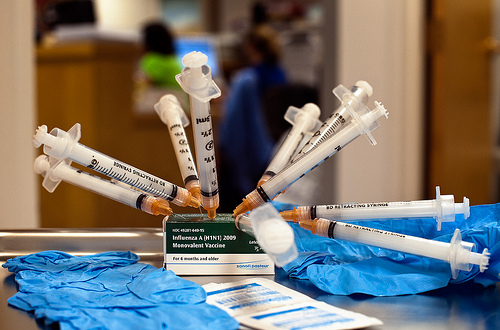Stasis Theory and Meaningful Public Participation in Pharmaceutical Policy
“…the absence of evidence is not evidence of absence.” (Hal Barron, MD [VP of Global Product Development and Chief Medical Office at Genentech Roche Pharmaceuticals], FDA Avastin Hearing, 29 June 2011)
“What endpoint then is sufficient for your approval? Months, years? Despite potential side effects from Avastin, metastatic breast cancer has only one, death. Certainly, Avastin can do no worse.” (Priscilla Howard [Breast Cancer Survivor], FDA Avastin Hearing, 28 June 2011)
The voices cited above are representative viewpoints of the medical professionals and breast cancer survivors who testified at a heated public hearing in which the FDA decided the fate of Avastin (bevacizumab) for the treatment of metastatic breast cancer. Avastin was first approved for the treatment of metastatic breast cancer under the Food and Drug Administration’s (FDA’s) accelerated approval program in February 2008, which made the drug publicly available for use in an expedited fashion. One condition of accelerated approval is that the pharmaceuticals must continue rigorous clinical trials that are later subject to the standard approval process. After Genentech Roche—the makers of Avastin—submitted the drug for final approval, the Oncologic Drugs Advisory Committee (ODAC) denied regular approval. This July 2010 denial was followed by a public outcry from breast cancer survivors and clinicians who viewed Avastin as a last line of defense. Responding to this fervor, the FDA granted a rare public hearing (convened on June 28 and June 29, 2011) to decide whether Avastin should continue to be approved as a treatment option for metastatic breast cancer patients.
Following this hearing and after a review of “thousands of pages submitted to a public docket [and] data from several clinical trials,” FDA Commissioner Margaret A. Hamburg, MD, announced that she was upholding the ODAC’s earlier finding and “revoking the agency’s approval of the breast cancer indication for Avastin” (FDA News Release). Specifically, Commissioner Hamburg stated “there was not, at the time of approval, credible evidence of increased overall survival or increased quality of life, and there is no such evidence now. Instead, CDER [the Center for Drug Evaluation and Research] based its accelerated approval on a different measure, referred to as ‘progression free survival’” (Hamburg). Avastin retains approval predominantly for the treatment of colorectal and other cancers; however, without the specific breast cancer indication, many insurance companies will no longer pay for patients to receive Avastin—a drug that can cost up to $5,000 per treatment (Medical News Today).
Questions regarding the appropriateness of the Avastin revocation or the validity of the arguments that led to that revocation are beyond the scope of this article. Rather, our goal is to analyze how the FDA’s deliberative procedures afforded the capture of key stakeholder discourse and whether that discourse is meaningfully incorporated into final policy decisions. In what follows, therefore, we describe the ways that disagreement about how meaningful clinical endpoints were defined—what we see as key stasis points in this deliberation—yielded a lack of agreement between stakeholders about whether Avastin should retain approval for the treatment of metastatic breast cancer. Our findings suggest that the FDA’s deliberative procedures might more adequately capture stakeholder testimony if they were to incorporate a prehearing event wherein all parties agreed to definitions for key stasis points.
Hybrid Methodological Approach
A hybrid of qualitative content analysis and rhetorical stasis theory was deployed as a way to analyze over 500 pages of transcripts from two days of Avastin Hearing testimony and Commissioner Hamburg’s seventy-page written decision that followed the hearing.1 Initial analyses of the data set yielded several key themes or patterns. We coded for the kinds of stakeholders involved in the hearing (e.g., advocates, survivors, healthcare practitioners, etc.), the regimes of practices from which each participant hailed (e.g., evidence-based medicine, clinical practice, survivorship, etc.), whether the participant was for or against Avastin’s approval, and moments in the debate where disagreement about a key issue in the debate was made explicit.
Each researcher identified that the final code—moments where disagreement was made explicit—consistently involved an invoking of how a meaningful “clinical endpoint” should be defined. The two primary definitions for a meaningful clinical endpoint were (1) progression-free survival (PFS) and (2) overall survival (OS). PFS is a statistical measurement of the average amount of time tumor growth is delayed while OS measures the average increase in lifespan for patients taking a given drug and is widely considered the gold standard in cancer pharmaceuticals research.2 The clinical trials designed to assess the efficacy of Avastin for breast cancer patients either did not measure or were not able to demonstrate an increase in OS. Qualitative data analysis software (i.e., nVivo 9) allowed us to numerically identify how many times PFS and OS were invoked in the data set. PFS was invoked more than 1,300 times, and OS was invoked 819 times. As a point of comparison, the word “cancer” was invoked 581 times, and “Avastin” itself was invoked 830 times. This preliminary finding—disagreement about the meaningfulness of either PFS or OS as an endpoint—led us to conduct a closer examination of the data set using Directed Content Analysis.3
Directed Content Analysis (DCA) is a qualitative coding procedure wherein content categories are determined by preexisting theory and research. In this case, we used stasis theory as an analytic lens in subsequent analyses because each researcher consistently identified disagreement about PFS versus OS as a moment of stoppage in the debate; stasis theory suggests that, in the course of any public debate, points of contention will arise that need to be adjudicated before the overall issue for which said debate was called can be decided. Traditional neoclassical stases include questions of fact (e.g., did something happen?), definition (e.g., how do we define it?), quality (e.g., is what happened good, bad, etc.?), and jurisdiction (e.g., is this the right time, place, etc. for this debate?). More recent scholarship in rhetorical theory has updated points of stasis to account for the nature of debate in science, healthcare, and health policy.4 This body of research has provided rhetorical studies with an elaborate taxonomy of medico-scientific stases—the full interrogation of which lies beyond the scope of this article.
The portion of our DCA coding schema discussed herein focuses on what are known as evidentiary and methodological stases,5 which respectively address the following questions: (1) What is the appropriate form of evidence in determining which drugs are effective? (2) What are the appropriate methodologies for conducting drug efficacy trials?
Hearing transcripts and the Decision of the Commissioner were coded for instances of evidentiary and methodological stasis.
Stasis in Action: The Avastin Hearings6
As the opening epigraphs suggest, the key issues on which Avastin’s approval hinged were (1) the paucity of acceptable evidence and (2) the methodological definition of “clinical benefit.” In fact, the following four questions outlined by the FDA in the first moments of the hearing point back to these two issues:
1. Do the . . . trials fail to verify the clinical benefit of Avastin for the breast cancer indication for which it was approved?
2. Does the available evidence on Avastin demonstrate that the drug has not been shown to be effective for the breast cancer indication for which it was approved?
3. Does the available evidence on Avastin demonstrate that the drug has not been shown to be safe for the breast cancer indication for which it was approved and that Avastin has not been shown to present a clinical benefit that justifies the risks associated with use of the product for this indication?
4. If the Commissioner agrees with the grounds for withdrawal set out in Issue 1, Issue 2, or Issue 3, should the FDA nevertheless continue the approval of the breast cancer indication while the sponsor designs and conducts additional studies intended to verify the drug’s clinical benefit? (Day 1, pp. 10-11, emphasis ours)
What counts as “clinical benefit” and “available, meaningful evidence” lies at the heart of the Avastin deliberations. Both evidentiary and methodological stases are best embodied by the debate about whether PFS was an acceptable and meaningful form of evidence. For instance, one participant in the hearing argued that “we strongly believe that the FDA should lead a broader public discussion at this time, not about whether a specific drug has met specific endpoints, but about whether those endpoints are even the right ones in the first place” (Dr. Ivy Ahmed, Advocate, Day 1, p. 84, emphasis ours). Additionally, early in the hearing, a clinician argued that he thought everyone should “agree that clinical trials are intended to be pure scientific experiments which must have valid endpoints. Progression-free survival or PFS is often the most objective and, hence, most valid endpoint in a clinical trial” (Robert Berger, Clinician, Day 1, p. 46). Yet another participant argued that
[u]nfortunately, the existing evidence from randomized controlled trials conducted by the drug’s manufacturer has demonstrated that Avastin has not lived up to the initial hype. Trials completed demonstrated some improvement in progression-free survival. We remain convinced that it is not enough to justify FDA approval for treating metastatic breast cancer. (Vernal Branch, Advocacy Organization Rep., Day 1, p. 97)
Our findings suggest that disagreement about whether Avastin should retain its approval for the treatment of breast cancerwere predicated on disagreement about the availability and appropriateness of efficacy evidence. The deliberators who maintained that Avastin’s approval for metastatic breast cancer should be revoked used the absence of OS data as a recurrent point of justification. For instance, one participant argued that “[p]rogression-free survival is an endpoint that benefits women with metastatic breast cancer only if it predicts overall survival or demonstrates improved quality of life. Avastin has done neither” (Helen Schiff, Advocacy Organization Rep., Day 1, p. 81).
In contrast, Avastin proponents argued for continued approval by using the clinical trials that treated PFS as the primary, meaningful measure. For instance,
[t]here is substantial anecdotal [evidence] from metastatic breast cancer patients and providers that indicates this combination results in increased progression-free survival as well as prolonged patient life. A study that includes data from patients and their doctors with Avastin and paclitaxel experience is appropriate. (Karen Zinka, Advocate, Day 1, p.112)
Embedded in each of these arguments are evidentiary or methodological stases that halt agreement about whether Avastin should retain approval for the treatment of metastatic breast cancer. That is, questions about whether PFS data counts as evidence or whether a lack of OS evidence should mandate revocation must be answered before the final decision can be made.
Available Evidence and Clinical Benefit: Beyond PFS and OS
But where do these stasis questions leave the public? If, as our analysis suggests, the Avastin decision was predicated primarily on evidentiary and methodological stases, then what place does that leave for the testimony of breast cancer survivors? Given the ways the deliberation hinged on PFS versus OS, it is clear that what counted as “available evidence” and “clinical benefit” for credentialed, researching stakeholders was based only in scientific literature; alternative definitions of available evidence presented by non- researching stakeholders (e.g., clinical oncologists, breast cancer survivors, etc.) were often implicitly excluded and sometimes explicitly marginalized. Preoccupation with whether OS was a more meaningful measure of clinical benefit than PFS actually served to distract from, if not discount, other kinds of evidence presented by non-researching clinicians, patients, and their families.
One hearing participant, for instance, anticipated the ways her evidence might not be deemed meaningful by the FDA: “I wish I could provide more than my individual case, as I know there are many variables. However, I hope the committee will consider individual experiences presented today as we represent the story behind the numbers” (Nancy Hauty, Breast Cancer Survivor, Day 1, pp. 30-31,). Another participant argued that “[a] woman’s individual experience with a treatment may be different than the aggregate results from a clinical trial” (Dr. Beth Baugham DuPree, Advocate and Healthcare Practitioner, Day 1, p. 67). A physician who treated his patient with Avastin pointed to a woman in the audience and implored the FDA to “[l]ook at Elizabeth. Does she look sick?” (Dr. Stanley Waintraub, Healthcare Practitioner, Day 1, p. 51). Two other examples demonstrate how other participants invoked very different kinds of evidence against Avastin’s approval:
1. The FDA’s decision on Avastin must be based on scientific evidence from well-done trials and cannot be based on any one individual story, no matter how compelling. This decision cannot be driven by anecdotes. It must be driven by science. (Christine Brunswick, Advocacy Rep., Breast Cancer Survivor, Day 1, p. 91)
2. While we acknowledge the pain and suffering caused by cancer, our job in making decisions about drug approval is to focus on the available scientific evidence. Our regulatory decisions are based on data from adequate and well-controlled clinical trials. (Richard Padzur, Center for Drug Evaluation and Research, Day 1, pp. 126-127)
So while the FDA reported strong interests and investments in the inclusion of key stakeholders (Lewis), the extent to which non-researching stakeholders’ testimony was elided in the Avastin deliberations is troubling. Members of the FDA did listen to 35 three-minute public presentations by so-called “non-parties”—including some of the voices cited above—, but these presentations amounted to no more than a quarter of the hearing.
Concluding Thoughts
Ultimately, our analysis suggests that the enactment of the four decision-making aims outlined at the outset of the trial followed by the FDA’s preoccupation with OS versus PFS after non-party testimony was completed invited and validated only certain kinds of testimony or debate—none of which included the testimony of non-researching experts (who, quite frequently, were as fully versed in the scientific specifications of the disease as FDA members). The FDA did not include as part of its deliberations an opportunity for all participants to agree upon (1) what would count as a clinical benefit and (2) what kinds of evidence would be deemed meaningful.
If future studies determine this to be a pervasive problem for FDA deliberations, then it might be of value to incorporate a kind of pretrial hearing wherein the very terms upon which the deliberation hinges are negotiated and successfully defined. The United States Supreme Court provides one model for achieving pretrial agreement about definitions for key terms; in cases where a plaintiff alleges patent infringement, a pretrial hearing is held wherein a judge determines the definitions for relevant keywords that will be invoked during the actual trial. This pretrial event is often referred to as a “Markman Hearing” or a “Claim Construction Hearing.” Judges in Markman Hearings yield to Federal Rules of Evidence in selecting experts to help construct claims and definitions. According to said Federal Rules of Evidence, expertise may come from “knowledge, skill, experience, training, or education” (Federal Rules of Evidence). A similar model may be of benefit to the FDA or other organizations charged with managing the science-policy interface.
Endnotes
- See Herndl et al., pp. 440-444, for an in-depth discussion of a similar hybrid approach. return
- See Zhuang, Ziu, and Elsayed, pp. 395-397. return
- See Hsieu and Shannon, pp. 1281-1283, for a discussion of Direct Content Analysis. return
- See, for example, Prelli, pp. 303-308; Fahnestock and Secor, pp. 431-435; and Graham and Herndl, pp. 160-165. return
- See, for example, Prelli, pp. 303-308, and Graham and Herndl, pp. 157-160. return
- For the following sections of this paper, we use a modified MLA citation style in order to reflect stakeholders’ ethos, day of debate, and page number in the official transcript, which can be found here. return
Works Cited
- Fahnestock, Jeanne, and Marie Secor. “The Stases in Scientific and Literary Argument.” Written Communication 5.9 (1998): 427-43. Print.
- Graham, S. Scott, and Carl G. Herndl. “Talking Off-label: A Non-modern Science of Pain in the Medical-Industrial Complex.” Rhetoric Society Quarterly 42.2 (2011): 145-67. Print.
- Hamburg, Margaret, and the Department of Health and Human Services Food and Drug Administration. “Proposal to Withdraw Approval for the Breast Cancer Indication for AVASTIN (Bevacizumab): Decision of the Commissioner.” 2011. Web. 19 Nov. 2011. PDF file.
- Herndl, Carl G., Jean Goodwin, Lee Honeycutt, Greg Wilson, S. Scott Graham, and David Niedergeses. “Talking Sustainability: Identification and Division in an Iowa Community.” Journal of Sustainable Agriculture 35.4 (2011): 436-61. Print.
- Hsieh, Hsiu-Fang, and Sarah E. Shannon. “Three Approaches to Qualitative Content Analysis.” Qualitative Health Research 15 (2005): 1277-88. Print.
- Lewis, Carol. “Advisory Committees: FDA’s Primary Stakeholders Have a Say.” FDA.gov, 18 June 2009. Web. 19 Nov. 2011.
- Prelli, Lawrence. ‘‘Stasis and the Problem of Incommensurate Communication: The Case of Spousal Violence Research.’’ Rhetoric and Incommensurability. Ed. Randy Allen Harris. West Lafayette, IN: Parlor, 2005. 294–333. Print.
- United States Committee of the Judiciary House of Representatives. “Federal Rules of Evidence.” 2010. Web. 19 Nov. 2011. PDF file.
- United States Food and Drug Administration. “FDA Commissioner Announces Avastin Decision.” 18 Nov. 2011. Web. 19 Nov. 2011. News Release.
- —. “Hearing on Proposal to Withdraw Approval for Breast Cancer Indication for Bevavizumb (Avastin).” 28, 29 June 2011. Web. 1 Oct. 2011.
- Zhuang, Sen H., Liang Xiu, and Yusri A. Elsayed. “Overall Survival: A Gold Standard in Search of a Surrogate: the Value of Progression-free Survival and Time to Progression as End Points of Drug Efficacy.” Cancer Journal 15.5 (2009): 395-400. Print.

![Stasis Theory_article_Image Cure per il Cancro, Autorità Sanitarie Usa Censurano Avastin [Lastra che Evidenzia un Tumore al Seno]. By Leandro Riccini Margarucci: http://www.flickr.com/photos/lupin71/4702621109/in/photostream/](http://www.presenttensejournal.org/wp-content/uploads/2012/08/Stasis-Theory_article_Image-e1349364484133.jpg)



 Christa Teston is an Assistant Professor of Technical Communication at the University of Idaho. Christa studies rhetoric and writing practices in medical and scientific contexts. Recently, she’s published research on medical imaging techniques in Technical Communication Quarterly, a book chapter on conducting research in confidential contexts in Practicing Research in Writing Studies, and an investigation of electronic medical records in SIGDOC 2012. Her 2010 Written Communication article was awarded NCTE’s “Best Article Reporting Qualitative or Quantitative Research in Technical or Scientific Communication.” Her current work explores issues of expertise and modes of argumentation at the intersections between scientific research and federal regulatory policy.
Christa Teston is an Assistant Professor of Technical Communication at the University of Idaho. Christa studies rhetoric and writing practices in medical and scientific contexts. Recently, she’s published research on medical imaging techniques in Technical Communication Quarterly, a book chapter on conducting research in confidential contexts in Practicing Research in Writing Studies, and an investigation of electronic medical records in SIGDOC 2012. Her 2010 Written Communication article was awarded NCTE’s “Best Article Reporting Qualitative or Quantitative Research in Technical or Scientific Communication.” Her current work explores issues of expertise and modes of argumentation at the intersections between scientific research and federal regulatory policy.  S. Scott Graham is an Assistant Professor in the Department of English at the University of Wisconsin-Milwaukee. There he teaches and conducts research in critical/cultural technical communication and rhetorics of science, technology and medicine. Scott has particular interests in the application of new materialisms and multiple ontologies theory for scholarship in rhetoric and technical communication. His current work explores issues of expertise and modes of argumentation at the intersections between scientific research and federal regulatory policy.
S. Scott Graham is an Assistant Professor in the Department of English at the University of Wisconsin-Milwaukee. There he teaches and conducts research in critical/cultural technical communication and rhetorics of science, technology and medicine. Scott has particular interests in the application of new materialisms and multiple ontologies theory for scholarship in rhetoric and technical communication. His current work explores issues of expertise and modes of argumentation at the intersections between scientific research and federal regulatory policy.